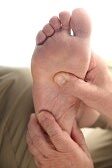Pain under the ball of your foot? You may have metatarsalgia.

Metatarsalgia is pain of the metatarsal heads, where the toes meet the long foot bones, under the ball of the foot. It is commonly described as burning, sharp pain or aching pain beneath the toes. Some people will describe it as feeling as though their sock is waded up or something is in their shoe.
Metatarsalgia is caused by a misalignment of the metatarsal bones relative to the phalangeal or toe bones, thereby causing stress and resulting inflammation and irritation to the soft tissues, the joint capsule and cartilage of the joint.
Contributing factors to this include:
- High impact sport: running, basketball, aerobics/step class, etc because of the increased absorption of the forefoot upon impact. Worn, ill fitting and unsupportive shoes contribute significantly to increased pressure on the metatarsal heads.
- Foot deformities and disease processes: high instep foot formations, pronation or dropped arches of the foot, hallux valgus or big toe bunions, Morton’s neuroma (a thickening of tissue around the nerves between the toes, typically between the 3rd and 4th toes) and rheumatoid arthritis can all cause increased pressure, inflammation or irritation of the metatarsal heads.
- Poor fitting shoes: high heeled shoes, wedge shoes (sole heel height is higher than toe height) and cowboy boots. These types of shoes transfer weight to the metatarsal heads thereby irritating this area. Shoes with a narrow toe box, tight fitting shoes and shoes that are too small can squeeze the toes together and result in stress upon the metatarsal heads.
- Fractures of the foot: esp stress fractures of the metatarsals, can cause weight to shift onto the metatarsal heads because of compensation.
- Aging and increased weight gain: As people age their fat pad on the bottom of their foot can get displaced and thinned causing increased pressure on the metatarsal joints. Weight gain, esp in the abdominal area, can cause the increased weight to shift forward onto the forefoot during exercise and even with simple walking.
Effective treatments:
- Proper fitting shoes with adequate sole cushioning and flexible support.
- Custom made, flexible orthotics (arch supports) are usually extremely effective for treating this condition. They should provide medial and transverse arch supports for the individual’s foot. The transverse arch will lift and spread the metatarsals in a slight curved nature in order to prevent “dropping” of the metatarsal heads.
- Non custom, flexible orthotics may also be adequate to support the foot, thereby decreasing stress to the metatarsal heads
- Foot adjusting can realign the displaced metatarsal heads in relation to the toes and the other bones of the foot.
- Low level, cold laser or ultrasound therapy to the metatarsal head area can decrease inflammation or irritation and significantly calm down the area.
- Soaking your feet in hot, Epsom salt bath. This simple home remedy can take some of the soreness out of the foot.
- Steroid injections in severe, non responsive cases may be required. However, this should be avoided if possible as the corticosteroid injections can cause soft tissue, muscular, tendinous and cartilage tissue to degenerate or rupture. Never a good thing. (Don’t let it get to this point.)